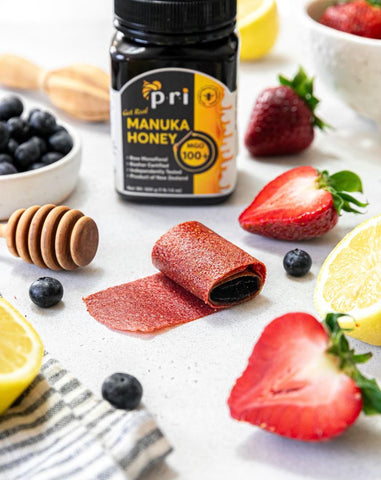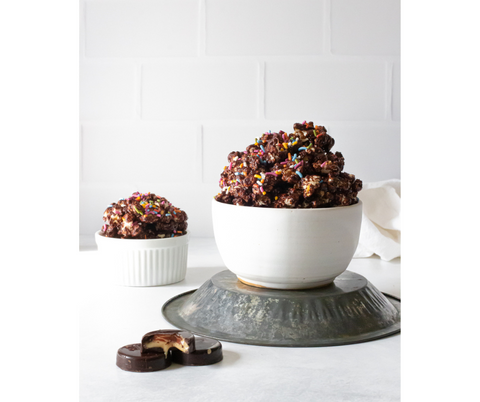
The Real Fruit Roll-Up
All Dressed Up for Independence Day
Does anyone else remember laying in the sun, unwrapping your roll of delicious sorta fruit with your friends and pretending you all had ridiculously long tongues? Just us?
You may even see us at the store on occasion, picking up a box of that big brand roll so we can fully immerse ourselves in sunny summer memories... but on other days we just make our own!
Since it is almost Independence Day, we had to go red, white, and blue, aka strawberry, apple, and blueberry. Of course, you can make them with pretty much any fruit you like... except watermelon, don't try watermelon. Cue endless amounts of straining for almost no end product
These are super simple to make and only have three ingredients: fruit, manuka honey, and lemon juice. The key ingredient here is patience as they will take 6-8 hours to fully dehydrate!
Our Real Fruit Roll-Ups are perfect for packed lunches, camping, hiking, road trips, BBQs, or just doing silly dances with your "tongue" out 🤪
Here are some directions in super long format, mostly for search engine purposes. Read on, if you love that stuff (no judgement) otherwise, click here to skip to the shorter version of this recipe!

Section 1: Ingredients and Equipment
- To make these delicious Real Fruit Roll-Ups, you will need the following ingredients and equipment:
- 3 cups strawberries
- 2 tbsp PRI Manuka Honey 100+
- 3 tbsp lemon juice
- 2 cups blueberries
- 8 oz unsweetened applesauce or pear applesauce
- Oven or dehydrator
- Silpat mat or parchment paper
- High-speed blender
- Small saucepan
- Baking sheet
Section 2: Strawberry Layer
- Wash and chop the strawberries, then place them into a high-speed blender.
- Add the PRI Manuka Honey 100+ and lemon juice to the blender.
- Blend the mixture until smooth.
- Strain the mixture to remove the seeds.
- Pour the strained mixture into a small saucepan and heat it on medium/low heat until it thickens.
- Let the mixture cool and set it aside.
Section 3: Blueberry Layer
- Rinse the blueberries and place them in a high-speed blender.
- Add the PRI Manuka Honey 100+ and lemon juice to the blender.
- Blend the mixture until smooth.
- Strain the mixture to remove any pulp.
- Pour the strained mixture into a small saucepan and heat it on low heat for a few minutes until it thickens.
- Strain the mixture again if needed and let it cool.
Section 4: Apple Layer
- For the apple layer, you can use either unsweetened applesauce or pear applesauce. Choose your preferred option and set it aside.
Section 5: Assembly and Cooking
- Preheat your oven to 170F or use a dehydrator.
- Place a silpat mat or parchment paper on a baking sheet and set it aside.
- Pour the strawberry layer onto the tray and spread it into an even layer using a spatula. Remember, the thicker the layer, the longer it will take to dehydrate.
- Next, spoon the applesauce onto the tray and spread it into an even layer with a spatula.
- Finally, pour and spread the blueberry layer onto the tray, creating the final layer.
- Cook the fruit layers in the oven or dehydrator for 6-8 hours, or until you can peel the fruit leather back.
Section 6: Finishing and Enjoyment
- Remove the tray from the oven or dehydrator.
- Place a piece of parchment paper over the silpat mat and peel the fruit leather off the mat.
- Roll the parchment paper with the fruit leather, creating a fruit roll-up.

Strawberry Layer:
- 3 cups strawberries
- 2 tbsp PRI Manuka Honey 100+
- 3 tbsp lemon juice
Blueberry Layer:
- 2 cups blueberries
- 3 tbsp PRI Manuka Honey 100+
- 2 tbsp lemon juice
Apple Layer:
- 8oz unsweetened applesauce or pear applesauce
- Preheat the oven to 170F or use a dehydrator. Place a silpat mat or parchment paper on a baking sheet and set aside.
- Wash and chop strawberries and place them into a high-speed blender with manuka honey and lemon juice. Blend until smooth.
- Strain the mixture to remove the seeds. Pour in a small saucepan and heat on medium/low heat until the mixture thickens. Let cool and set aside.
- Rinse blueberries and pour into a high-speed blender with manuka honey and lemon juice. Blend until smooth.
- Strain the mixture to remove the pulp. Pour in a small saucepan and heat on low heat for a few minutes until the mixture thickens. Strain again if needed and let set aside to let to cool.
- Pour strawberry layer onto the tray and spread into an even layer with a spatula. The thicker the layer the longer it will take to dehydrate.
- Next, spoon the applesauce onto the next layer and spread into an even layer with a spatula.
- Finally, finish with the blueberry layer, pour and spread into an even layer with a spatula.
- Cook for 6-8 hours, until you can peel the fruit leather back.
- Remove from the oven, place a piece of parchment over the silpat mat and peel the fruit leather off the silpat mat.
- Roll the parchment with the fruit leather until you have a fruit roll up and enjoy!

Our homemade Real Fruit Roll-Ups are not only delicious but also a perfect way to celebrate Independence Day. Recreate those nostalgic memories while enjoying the red, white, and blue flavors. Whether it's for packed lunches, camping adventures, road trips, or simply having fun, these roll-ups are sure to bring a smile to your face.






























